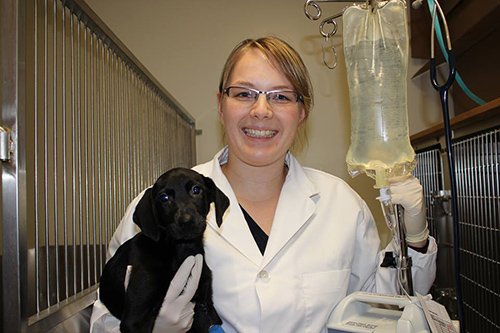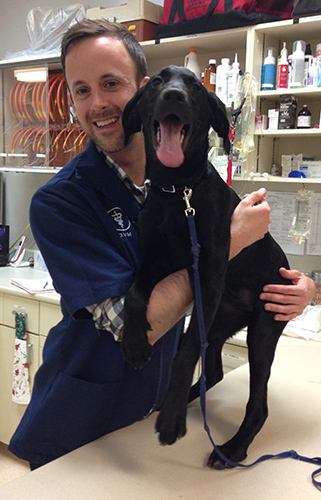
Preventable Disease and Vaccination Efficacy; risks abound yet the debate continues. A Case on Parvovirus.
Vaccinations come with varying opinions and emotional disagreements. Opinions range from the frequency of administration and, in some cases, whether they should be given at all. Veterinarians and human physicians strive for the betterment of the individual patient; as such preventative medicine is often the key to long-term success. They are also mandated with the protection of the population at large as public health and zoonotic diseases (those contracted by and spread between animals and people) lead to greater morbidity. Vaccinations have become an important component to the reduction, and in some cases, complete elimination of deadly diseases.
Canine parvovirus (CPV) first appeared in dogs in 1978 and is very similar to feline panleukopenia (also known as feline distemper). These diseases spread rapidly in unprotected populations causing severe illness leading to high numbers of mortality in those that become infected. There is no evidence to suggest either of these viruses can infect humans or other species outside of dogs and cats respectively.
Canine parvovirus is contracted by the ingestion of the virus from an infected dog’s feces. There does not need to be dog-to-dog contact as the virus can survive in the environment. Once contracted, the virus invades the gastrointestinal tract leading to inflammation and intestinal wall breakdown resulting in malabsorption, vomiting and diarrhoea (often bloody), and subsequently severe dehydration, electrolyte imbalances and malnutrition. Septicaemia (infection from intestinal microbes spreading through the bloodstream from intestinal wall breakdown) is a huge risk factor in terms of survival. Young puppies (less than five months of age) are most at risk for infection and death.
 Treatment for parvovirus infection is supportive as there is no cure for the virus. Intensive care involving intravenous fluids to correct the dehydration and electrolyte abnormalities, antibiotics (often multiple for a broad spectrum of bacterial sensitivity), and antiemetics and gastrointestinal protectants to control vomiting and help the gastrointestinal tract heal are required. Parenteral nutrition or another form of assisted feeding is needed to combat malnutrition and to help support the body’s natural defences to combat this virus, otherwise starvation would result in fatality. A strict isolated environment while hospitalized is also required given the highly contagious nature of this virus and its long-duration of survival in the environment.
Treatment for parvovirus infection is supportive as there is no cure for the virus. Intensive care involving intravenous fluids to correct the dehydration and electrolyte abnormalities, antibiotics (often multiple for a broad spectrum of bacterial sensitivity), and antiemetics and gastrointestinal protectants to control vomiting and help the gastrointestinal tract heal are required. Parenteral nutrition or another form of assisted feeding is needed to combat malnutrition and to help support the body’s natural defences to combat this virus, otherwise starvation would result in fatality. A strict isolated environment while hospitalized is also required given the highly contagious nature of this virus and its long-duration of survival in the environment.
The best course of prevention for canine parvovirus and many other viruses is vaccination. This requires proper vaccination of and immunity in the mother prior to parturition (giving birth). Puppies receive initial immunity from their mother’s first milk (colostrum). This immunity; however, wanes quickly over weeks to months and thus proper vaccination of the puppies is essential to preventing their risk of contracting this and other viruses. Typically vaccinations in puppies are begun by eight weeks of age.
If the mother was not properly vaccinated, the puppies will be at risk of infection from day one after birth. Adult dogs tend not to get clinically sick if they are exposed to parvovirus, they do however shed the virus in their feces increasing the risk to all others sharing that environment. Because of this, many puppies bred and sold through ‘backyard breeders’ come with increased risks of disease. Stories such as Mica’s (see our Facebook post) are not uncommon when dogs are bred in careless and inhumane ways. Mica was only one puppy saved out of many that die or are euthanized every year because of this one virus alone. A virus that is easily and effectively combatted through a simple and inexpensive vaccination with minimal risks in comparison.
Although vaccinations come with heated debates and opinions, they exist for a reason, to help prevent deadly disease in both our animal and human populations. With recent opinions and people choosing to stray away from vaccinations diseases have become more prevalent in both animal and human populations. Please discuss your concerns with and the recommended protocols for vaccination with your family veterinarian. If you have reservations, an informed discussion on the risk/benefits and alternatives to regular boosters of these vaccinations (such as checking titres) needs to happen between you and your family veterinarian.
For more information on parvovirus please see:
